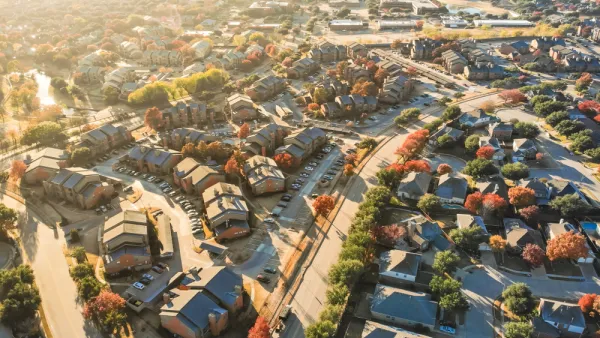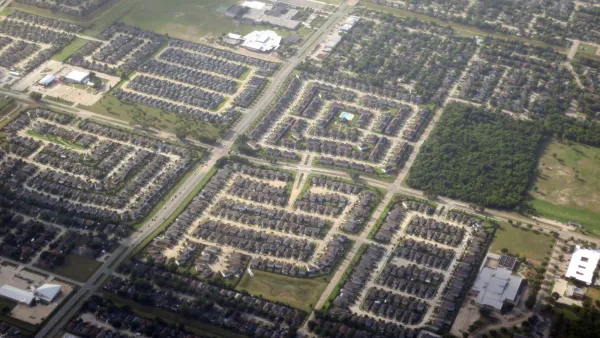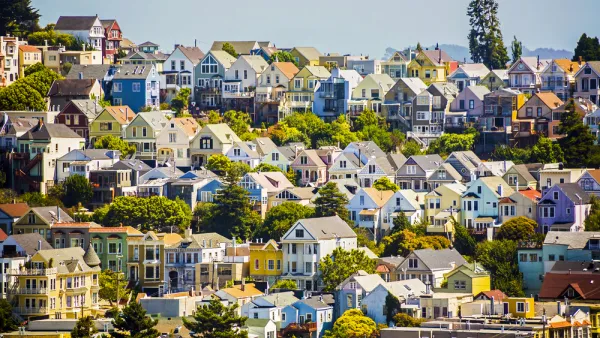Despite media commentary about urban gentrification and the decline of suburbia, suburbs still have far less than a proportionate share of regional poverty.
One story I've read over and over again is as follows: cities are getting richer—so much so that suburbs are turning into slums, and poor people are being driven into suburbia by exploding rents. The story comes from urbanists celebrating the rebirth of cities, and from egalitarians who worry about gentrification. And this "story" has some basis in reality: some urban neighborhoods are indeed growing wealthier, and some cities (including my own New York) suffer from out-of-control housing costs. And it is also true that some suburbs are becoming quite poor.
But is it really true that our cities are suffering from a shortage of poverty? If it was, we would find that cities have lower poverty rates than suburbs.
To examine the question, I looked at 2007 and 2012 American Community Survey figures for several major cities and their suburbs.(FN1) In particular, I focused on the six cities where a quarter or more of the population used public transit, because these are the cities where municipal boundaries are most likely to coincide with pre-sprawl development (as opposed to cities such as Jacksonville which include large chunks of suburban land). I found that in all six of these cities (Boston, Chicago, New York, Washington, Philadelphia and San Francisco) poverty actually increased during the economic downturn. I also found that in all of these cities, poverty rates were higher in central cities, although the city/suburb gap was usually somewhat smaller than it had been before the economic downturn.
Specifically:
*In Boston, poverty was almost three times as high in the city as in the suburbs before the recession (20.4% city, 7.2% suburb). Today, poverty is "only" 2.3 times higher (20.5% city, 8.9% suburbs). At this rate, the suburbs will be as poor as the city in about 2080.
*In Chicago, poverty was 2.7 times higher in the city before the recession (20.5% city, 7.7% suburbs). Now, poverty is "only" 2.2 times higher (23.9% city, 11% suburbs).
*In New York, poverty was 2.7 times higher in the city before the recession (18.5% city, 6.8% suburbs). Today, poverty is "only" 2.3 times higher (21.2% city, 9.3% suburb).
*In Philadelphia, poverty was over three times as high in the city before the recession (23.8% city, 7.4% suburb). This is still the case (26.9% city, 8.7% suburb).
*In supposedly hyper-gentrified San Francisco, the city/suburb gap actually widened during the recession. In 2007, city poverty was 10.5%, only 1.3 times higher than in the suburbs (8.2%). In 2012, the city poverty rate zoomed to 15%, 1.5 times the suburban poverty rate (10.1%).
*In Washington, D.C., the 2007 city poverty rate was three times that of suburbia (16.4% city, 5.5% suburbs). Today, Washington's urban poverty rate is "only" 2.5 times higher (18.2% city, 7.1% suburbs).
Some cities do have lower city/suburb gaps than these older cities. For example, Seattle's poverty rate is only 1.3 times that of suburbia (13.6% city, 10.8% suburb), and Portland is close on its heels (17.7% city, 12.5% suburb). But these cities include dozens of square miles of suburban sprawl, and thus might not be comparable to cities that were "built out" in 1950.
In sum, cities might be losing their middle class. But they don't seem to have any problem keeping the poor.
FN1: Data for suburbs is available in this Brookings Institution report, at the data appendix. Data for cities is available at the American Community Survey (temporarily unavailable due to the government shutdown).

Analysis: Cybertruck Fatality Rate Far Exceeds That of Ford Pinto
The Tesla Cybertruck was recalled seven times last year.

National Parks Layoffs Will Cause Communities to Lose Billions
Thousands of essential park workers were laid off this week, just before the busy spring break season.

Retro-silient?: America’s First “Eco-burb,” The Woodlands Turns 50
A master-planned community north of Houston offers lessons on green infrastructure and resilient design, but falls short of its founder’s lofty affordability and walkability goals.

Test News Post 1
This is a summary

Analysis: Cybertruck Fatality Rate Far Exceeds That of Ford Pinto
The Tesla Cybertruck was recalled seven times last year.

Test News Headline 46
Test for the image on the front page.
Urban Design for Planners 1: Software Tools
This six-course series explores essential urban design concepts using open source software and equips planners with the tools they need to participate fully in the urban design process.
Planning for Universal Design
Learn the tools for implementing Universal Design in planning regulations.
EMC Planning Group, Inc.
Planetizen
Planetizen
Mpact (formerly Rail~Volution)
Great Falls Development Authority, Inc.
HUDs Office of Policy Development and Research
NYU Wagner Graduate School of Public Service





























